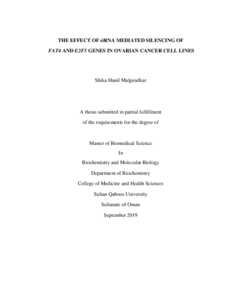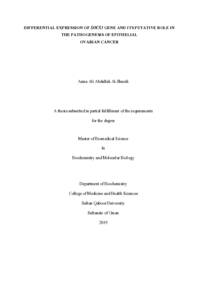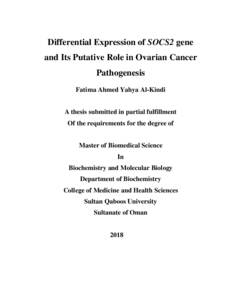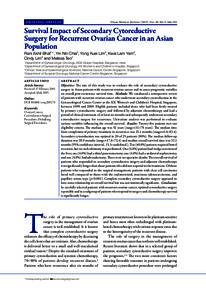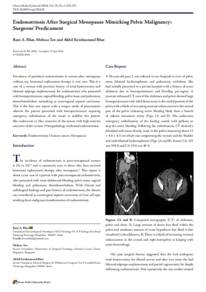وثيقة
The effect of siRNA mediated silencing of FAT4 and E2F5 genes in Ovarian cancer cell lines
الناشر
Sultan Qaboos University
ميلادي
2019
اللغة
الأنجليزية
الملخص الإنجليزي
Background: Epithelial ovarian cancer (EOC) is a lethal gynecological malignancy accounting for about 90% of ovarian cancer. Although molecular biology techniques (e.g., gene expression profiling, next-generation sequencing) have identified predictive markers, none of them is reliable. Thus, understanding the underlying molecular mechanism of EOC is essential to identify biomarkers for improving survival rates. A previous study performed chromatin immunoprecipitation using E2F5, and revealed that FAT4, a tumor suppressor gene acting through the Hippo pathway, and a cadherin super- family member implicated in several cancers, was one of the downstream genes regulated by E2F5 in EOC.
Objective: FAT4 has not yet been tested in EOC, making it an original topic strongly qualified for this study. We aimed to investigate the involvement of FAT4 gene in EOC, by quantifying its expression in MCAS, OVSAHO, A2780 cpr, and A2780 cps ovarian cancer cell lines, and compare to the normal ovarian cell line, HOSE 6-3. We also aimed to identify the pathway linking FAT4 and E2F5 in EOC pathogenesis.
Method: We evaluated the differential expression of FAT4 and E2F5 genes in four ovarian cancer cell lines using qRT-PCR and western blotting. We knocked-down FAT4 and E2F5 genes in MCAS, and OVSAHO using siRNA, and monitored the knockdown at the mRNA and protein levels. The effect of FAT4-silencing on cell viability and invasion of cancer cells were assessed by Alamar blue and cell invasion assay. The mechanism linking FAT4 and E2F5 was evaluated by assessing the expression of key proteins involved in Hippo, Wnt, Retinoblastoma, and apoptotic pathways.
Results: MCAS and OVSAHO ovarian cancer cell lines showed higher expression of FAT4 compared to A2780 cps and cpr. Knockdown of FAT4 in these cell lines enhanced cell viability (p=0.0001), invasion (p=0.0001) and colony forming ability, while E2F5 repression inhibited cell growth (p=0.0043 in MCAS and p=0.0139 in OVSAHO) and colony formation. Interestingly, we found that silencing FAT4, significantly upregulated the expression E2F5, vimentin (p=0.0001), YAP (p=0.0013), β-catenin (p=0.0083), cyclin D1 (p=0.0001), cdk4 (p=0.0001), and Bcl2 (p=0.0001) as compared to control. In contrast the expression of GSK-3-β (p=0.0084), Rb (p=0.0028) and caspase 9 (p=0.0068) was lower. In E2F5 siRNA treated cells, the levels of vimentin (p=0.0001), pYAP (p=0.0138), GSK-3-β (p=0.0004), β-catenin (p=0.0285), pβ-catenin (p=0.0001) and retinoblastoma (p=0.0338) was higher, while the expression of pRb (p=0.0491), cyclin D1 (p=0.0002), cdk4 (p=0.0082) and caspase 9 (p=0.0033) was lower than the control. This could be useful information to identify not only good biomarkers for early detection of EOC but also genes to be targeted for treatment.
Conclusion: Down-regulation of FAT4 in ovarian cancer cell lines promotes growth and invasion via the modulation of wnt, apoptotic, Rb and Hippo
الوصف
Thesis
المجموعة
URL المصدر
قالب العنصر
الرسائل والأطروحات الجامعية

